Last updated: June 4, 2018
Article
Fly fishing
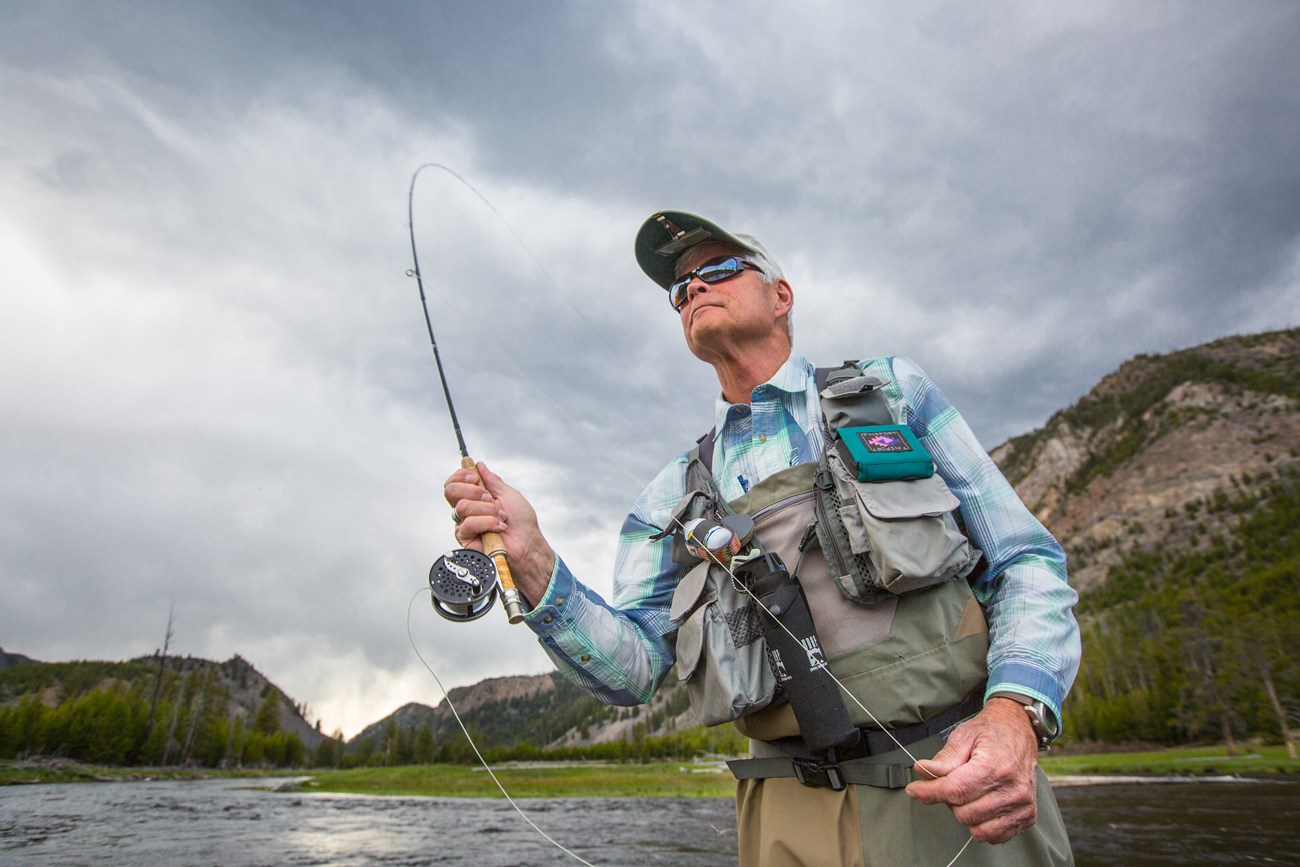
NPS Photo / Neal Herbert
The thick, yellow fishing line goes “whoosh!” as it zips past you before gently landing on the lake in front of you. A small lure (called a “fly”) that looks like an insect floats across the surface of the water. Then a ripple appears in the same spot as your lure, and a fish tail flashes above the water. You set the hook and the fight is on!
Whether you’re chasing 6-inch brook trout, picture-worthy cutthroat, or 15-pound striped bass, fly fishing is a unique and exciting way to experience our national parks! It offers serenity and views that are unmatched by almost any other form of recreation.
What is fly fishing?
Fly fishing is one of the most adventurous ways to enjoy National Park Service (NPS) lands and waterways. It often involves walking or hiking to your fishing spot, which can sometimes be a dozen miles in to the backcountry. Although not all fly fishing happens in high-alpine lakes, it can be done almost anywhere from the seashore to streams and everywhere in between.
While fly fishing is both a fun and relaxing way to fish, it also requires the most patience and skill. That’s mostly because of the equipment involved - long, thin, flexible rods, two different types of fishing line, and small, delicate flies - is different than most fishing gear and can be difficult to use at times. It takes time, practice, and patience to become skilled with a fly rod.
Fly fishing gets its name from the lures used. They’re referred to as “flies” because they’re made to imitate small insects or prey items that a fish may want to eat. Flies are usually made out of materials like yarn, sewing thread, feathers, fur, and a single hook. Flies also range in size from as small as a grain of rice to the size of a 10-inch fish.
How to fly fish
Fly fishing is all about rhythm. Finding the right rhythm and movement is the key to casting a fly rod. The mechanics of casting can be broken down into several steps. Remember that the best way to learn is through practice.
An easy way to learn how to cast a fly rod is to picture the movements of your arm on a clock. When your arm is in the neutral position (when it’s up and directly in line with your body), it’s at 12 o’clock. When your arm is forward during your cast, it should be at 10 o’clock. During your back cast, your arm should be at 2 o’clock. By keeping you arm in this small window of movement, you’ll be able to have both control and power in your casts.
To start your cast, let out about one rod length of the colored fly line. You only need to hold the rod with one hand - keep the other hand free to help manage your line. Start your cast by slowly swinging the rod behind you, in the 2 o’clock position. Keep the rod tip up, and once the rod tip gets just past your shoulder, at 10 o’clock, make your forward cast in one smooth, continuous motion letting the line rest on top of the water
Be careful not to use the rod like a whip - any casts that are too sudden and sharp will cause the fly to snap off from the leader, or scare away any potential catches.
When you’re casting you can let more line out. This will help get your fly further out onto the water and closer to the fish. To make your line longer during a cast, pull some line from the reel in between casts.
When you make your cast, bring the rod forward and backward several times like you would normally cast, but don’t let the fly hit the water. This is called false casting. Practice your false cast several times to find the right rhythm. Once you have a rhythm, get ready to let more line out. To let more line out, hold the excess line in your other hand and keep some tension on it. As you make your forward cast, let go of some excess line. The momentum of the cast will bring the line out and make the line go further out. Repeat this process until your line is as long as you want it.
If a fish bites your fly, be ready to set the hook! Setting the hook when a fish bites helps keep the fish on your line. There are two ways to set the hook when fly fishing - a convex (rod) set or a strip set. A convex set means you pull back on the rod in a sudden, hard motion once the fish takes your fly. A strip set is when you pull on the line with your free hand once a fish bites your fly. The strip set is done with a single, hard tug on the line while keeping the rod motionless.
Gear for fly fishing
Fly fishing requires more gear than most other types of fishing, but the amount of gear you use depends on where you’ll be fishing and what you’ll be fishing for. Other factors like time of day, season, and how you plan on accessing your fishing spot also determine what gear you need.
From rods to reels and wading boots to flies, it can be very confusing when it comes to choosing the right gear for fly fishing. Check out these descriptions of some of the gear (tackle):
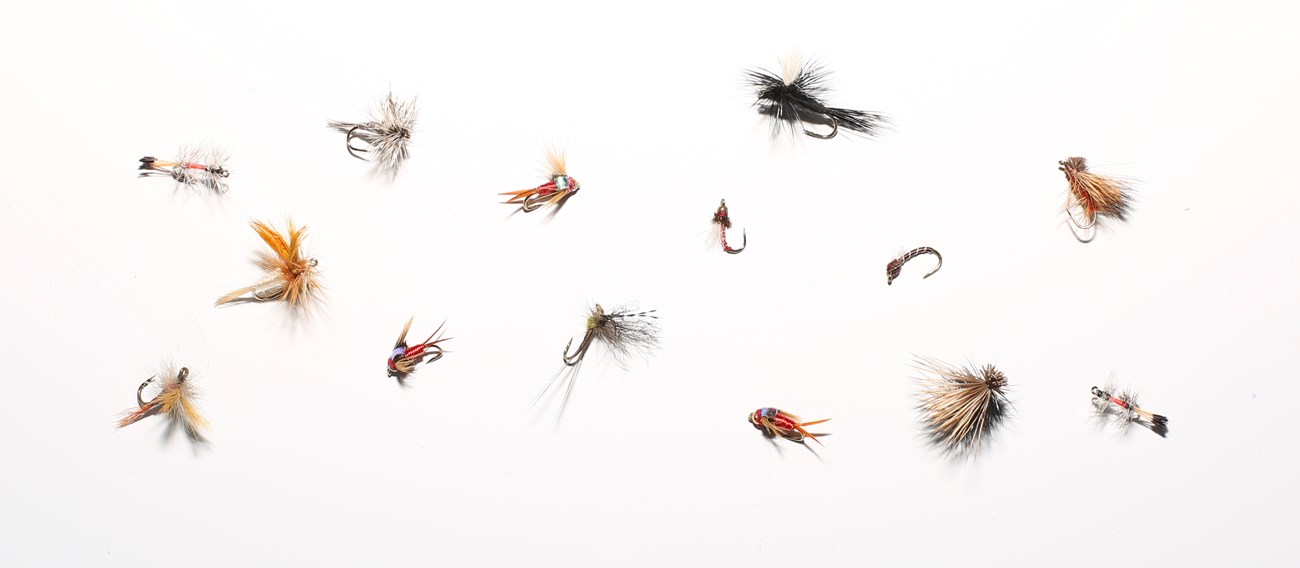
NPS Photo / Forrest Czarnecki
-
Fly rod: Having the right fly rod can make or break your fishing trip. Fly rods come in all different sizes and weights (often referred to with a # (pound) sign). Different sizes and weights are made for different species of fish. Common sizes of fly rods are 8 feet, 8 feet 6 inches, 9 feet, 9 feet 6 inches, and sometimes longer. Common weights are between #3 and #7, with #5 being the most common. A #3 weight rod is very light and is meant for catching small fish like brook trout or panfish. A #5 weight rod is considered medium weight and is suited for catching medium/large fish such as cutthroat trout and bass. A #7 weight rod (or heavier such as a #9 or #12) is very heavy, and is used for catching large fish like striped bass or salmon.
-
Fly reel: These reels are specially designed to go with a fly rod. They’re not like any other fishing reel, and choosing the proper reel is important for being able to cast your rod. Fly reels help balance a rod, and they hold all of the fly line and backing, which is important for catching and fighting a fish.
-
Fly line: Fly line often refers to the colored section of line on a reel. This heavy, thicker, colored section of line is what makes it possible to cast your fly. Fly line comes in many different types including floating, sinking, and different weights (weight forward, tapered, shooting, and several others). It also comes in different weights, similar to a rod. Choose the appropriate weight and type of line for the species you’re after.
-
Leaders: The leader is the smaller, clear section of fishing line that’s tied to the end of the regular fly line (discussed above). The leader is where you attach your fly. It can come in different sizes (referred to with an “x” after the size, for example a size 6 leader is called a “6x”). Just like fly rods, you’ll need to choose your leader wisely depending on the species you want to catch and the flies you’re using. Smaller leaders (like a 6x or 5x) are best suited for smaller flies, and are commonly used when trout fishing. Heavier leaders (like a 3x or 4x) are meant for larger flies and bigger fish. Heavier leaders are also used for connecting the fly line to smaller sections of the leader. For example, a section of 4x leader will connect the fly line (colored line) to a section of 5x leader, where the fly is tied.
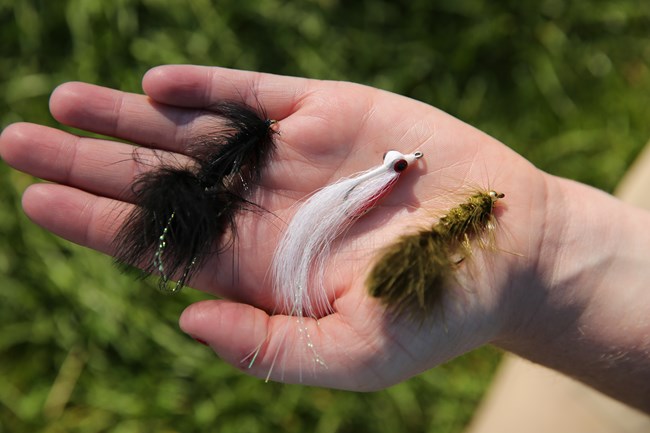
NPS Photo / Forrest Czarnecki
-
Flies: Fly selection is crucial for having a successful fishing trip. If your fly doesn’t look like what the fish wants to eat, you’re going to have a hard time catching fish. With flies, you need to try and “match the hatch,” or use a fly that looks like the ones the fish are feeding on at the time. Flies come in many different types: midges (small, sinking flies), dry flies (small to medium floating flies), and streamers (larger, heavier flies that look like insects, mice, and other fish). Choosing the right fly also depends on the rod and line/leader combo you’re using. Lighter flies will go with lighter gear, and heavier flies with heavier gear.
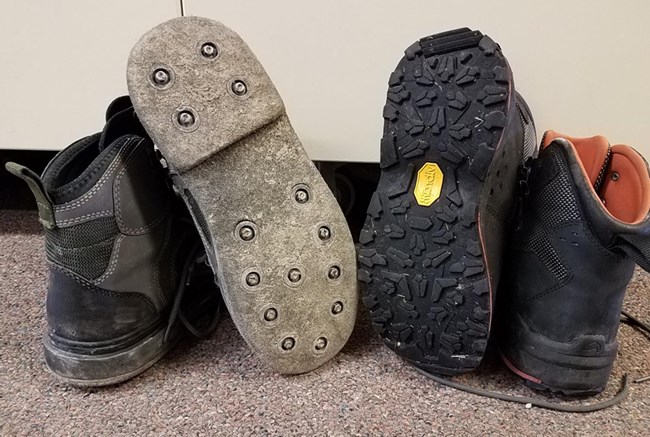
NPS Photo / Todd Koel
-
Waders and wading boots: Waders can come in a variety of styles, shapes, and sizes, but they’re essentially a pair of waterproof overalls (or pants) that keep you dry when you’re standing in a lake or river. Wading boots can either be attached to the waders or put on separately. Wading boots use special grip to help you have good footing in wet, rocky terrain. Try to avoid boots with felt soles, which have been known to transport invasive aquatic organisms into different waterways. Some parks prohibit the use of felt-soled wading boots.
If you’re feeling a little unsure or overwhelmed by the different types of gear and terms, stop by your local fly shop or fishing store and ask employees for their advice. When choosing flies, be aware of any park regulations that prohibit barbed hooks or lead weights. Barbs can be removed by crimping them flat with a pair of pliers.
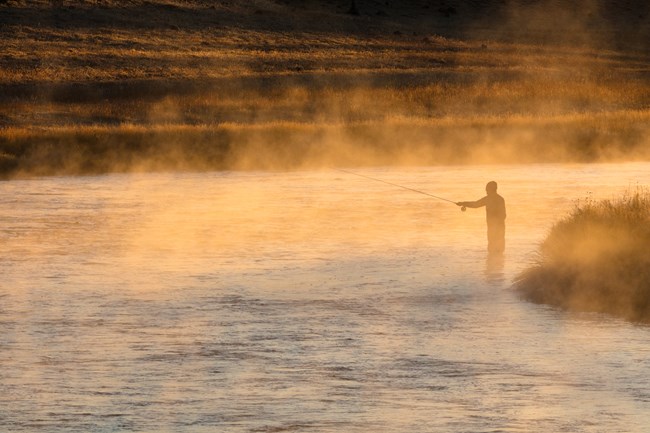
NPS Photo / Jacob W. Frank
Where to fly fish
Where you choose to go fly fishing depends on the kind of experience you want. Do you want the solitude and sense of place that comes with fly fishing for high-alpine cutthroat trout? Or the adventure and anticipation that comes with chasing large striped bass in a big lake? Are you planning on hiking to your destination, or just a short walk from the parking lot?
Fly fishing isn’t limited to just banks or shorelines. It can also be done from boats and other personal watercraft like a kayak or canoe if you’re fishing on a big lake. Doing some research before your trip will help you decide where you want to fish and what fish species are found there.
Expectations for fly fishing
From battling a picture-worthy cutthroat trout to landing a 15-pound striped bass, and even catching dozens of small panfish, fly fishing offers a wide variety of experiences. Some offer solitude and vast expanses of wilderness, while others offer small crowds and huge bodies of water. Here is a helpful list of questions to keep in mind when planning your next fly fishing trip:
-
Where will I be fishing?
-
How will I get to my fishing spot?
-
What kind of fish live there?
-
What kind of fish do I want to catch?
-
What kind of flies will I use to catch them?
-
Where will I be standing when I’m fishing?
-
What kind of experience am I after?
Before you head out for your next adventure, be sure to check park regulations and have a valid fishing license. Some parks prohibit the use of barbed hooks, and some parks require or encourage catch and release of certain fish species.
If you’re going fly fishing, bring lots of patience. This type of fishing requires more focus, attention to detail, and skill than many other types of fishing. It may take a little bit of practice (and yes, patience) to learn some of the mechanics of fly fishing like casting and knot tying. But the best way to practice is to get out there!
